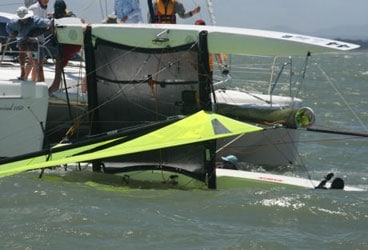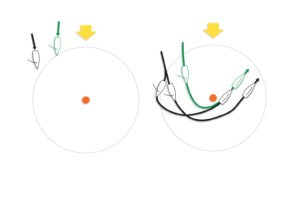
MarRulesSt
Every year in November, the ISAF Racing Rules Committee meets for an entire day, and it usually devotes most of its time to discussing proposed rule changes for the next edition of the rulebook. Last November’s meeting in Helsinki was unusual in that the committee spent quite a bit of time interpreting how the current rules apply in three situations. All three involve issues that have been hotly debated among international race officials.Circling an obstruction before the startThis incident will be a new call in The Call Book for Match Racing (Call UMP 6, Q&A 3 and Q&A 4). In this incident, the applicable rules in match racing are identical to the rules that would apply in a fleet race. Here are the facts: As shown in the diagram at right, before the starting signal Andy and Ben are reaching on starboard tack as they approach an anchored spectator boat. When Andy reaches the two-length zone, he is clear ahead of Ben. Just before position 2, the boats are sailing parallel courses and Ben becomes overlapped inside Andy. At position 3 Andy jibes onto port tack and begins to turn to port. He continues to turn and, just after position 4, the boats collide. How do the rules apply to this incident? The anchored boat is an obstruction that the boats are leaving on the same side. From the moment Andy reaches the two-length zone around the boat, Rule 18.2(c) requires Ben to keep clear of Andy until they both have passed it. Rule 18.2(c) also states that Ben is not entitled to room when he becomes overlapped inside Andy. In this situation room means “the space [Ben] needs in the existing conditions while passing or rounding between [Andy] and the [anchored boat] promptly in a seamanlike way” (see the preamble to Rule 18 and the definition Room).At position 3, Andy needs to act to avoid Ben, who is taking room he is not entitled to have, and so Ben breaks Rule 18.2(c) (see the definition Keep Clear). Because the anchored boat is an obstruction and not a mark and also because the incident takes place before the starting signal, Rule 18.2(d) does not apply. Therefore, Rule 16.1 applies to Andy as he changes course. It requires him to give Ben room- i.e., “the space [Ben] needs in the existing conditions while manoeuvring promptly to keep clear [of Andy] in a seamanlike way.” Between positions 3 and 4 Andy continues to turn, fails to give Ben that room and, therefore, breaks Rule 16.1. Andy also breaks Rule 14 because it was possible for him to have avoided the contact with Ben. Because both boats break rules, both are penalized.Andy could have escaped being penalized. Right after position 3, if he had borne away and given Ben room to keep clear, then he would not have broken Rules 16.1 and 14. In that case, only Ben would be penalized.Rounding the leeward markISAF accepted US SAILING Appeal 92 for inclusion in The Case Book. The incident is shown in the second diagram. Al and Beth are sailing cruising boats on converging courses toward a leeward mark they are required to leave to port. Beth’s boat is larger and she is overtaking Al. Just before Al reaches the two-length zone he hails, “No overlap” and Beth hails, “Overlap” and, “Room at the mark.” By position 2 Beth is overlapped inside Al, and between positions 2 and 3 Al luffs sharply into Beth’s path, resulting in a collision and damage. The force of the collision spins Al’s hull counter-clockwise so that his bow hits the mark. Each boat protests the other. How do the rules apply to this incident?This situation is similar to the match-racing situation described above. However, because the boats are rounding a mark after the starting signal and because Al has right of way over Beth, Rule 16.1 does not apply to Al as he changes course to round the mark (see Rule 18.2(d)).The conflicting hails were evidence that there was “reasonable doubt” that Beth obtained an overlap in time. The appeals committee interpreted “reasonable doubt” in Rule 18.2(e) to refer both to doubt by the boats involved in the incident and to doubt by the protest committee during a hearing.Because Beth had been clear astern of Al before the incident, under Rules 18.2(c) and (e), she should have presumed that the she did not obtain an overlap in time and kept clear of Al during the rounding. The protest committee, after hearing the testimony, had “reasonable doubt” about the overlap. Acting under Rule 18.2(e), it presumed that the overlap was not obtained in time and, therefore, that Beth broke Rule 18.2(c). Also, Beth should have been aware that Rule 18.2(d) permitted Al to change course to round the mark without giving her room to keep clear. She could have avoided the contact by acting to avoid Al before he luffed. So she also broke Rule 14 (Avoiding Contact).Al argued during the hearing that Rule 18.2(d), which gave him the right to luff without regard for whether Beth had room to keep clear, conflicted with Rule 14, and that, under the preamble to Section C rules, Rule 18.2(d) (Changing Course To Round or Pass) took precedence over Rule 14. Al concluded that he was not obligated to comply with Rule 14. The appeals committee disagreed. It pointed out that no part of Rule 18 permits a boat to collide with another boat or “conflicts” with Rule 14. The committee ruled that Rule 14 applied to Al and that, at position 2 when it became clear that Beth was not keeping clear of Al, Al should have acted to avoid contact. Had he held his course or borne away he could have avoided the contact. Therefore, the committee decided that Al broke Rule 14. Al touched the mark, thereby breaking Rule 31.1. However, the committee ruled that Al was compelled to touch the mark as a consequence of Beth’s breaking Rules 18.2(c) (Not Overlapped At The Zone) and 14. So, under Rule 64.1(b), the committee exonerated Al from his breach of Rule 31.1 (Touching A Mark).Two features of this decision had been hotly debated among ISAF race officials-(1) whether “reasonable doubt” in Rule 18.2(e) refers to doubt by the boats involved, doubt by the protest committee, or both, and (2) whether Rule 18.2(d) conflicts with Rule 14. Both issues are resolved by this new case.Protests under Rule 28.1When a boat intends to protest another boat concerning an incident in the racing area that she is involved in or sees, Rule 61.1 requires her to hail “Protest” and (if her hull is at least 6 meters long) display a red flag at the first reasonable opportunity. However, if the other boat is beyond hailing distance, the protesting boat need not hail but must inform the other boat at the first reasonable opportunity.Suppose that the course requires boats to round an offset mark to port after rounding the windward mark and before rounding the leeward mark. Tom rounds the windward mark in first place but forgets the requirement to round the offset mark. As a result, he makes an error in sailing the course-he leaves the offset mark to starboard. He then sets off down the run, rounds the remaining marks on the required side in the correct order and finishes. Jerry sees Tom leave the offset mark to starboard. He knows that Rule 28.1 permits Tom to “correct any errors to comply with this rule.” Jerry asks when he must comply with Rule 61.1 in such a situation? The ISAF Racing Rules Committee discussed this issue. It noted that Tom could have corrected his error any time before he finished. It ruled that Tom did not break Rule 28.1 until that time, and that Jerry was not required to comply with Rule 61.1 until then.E-mail for Dick Rose may be sent to rules@sailingworld.com









